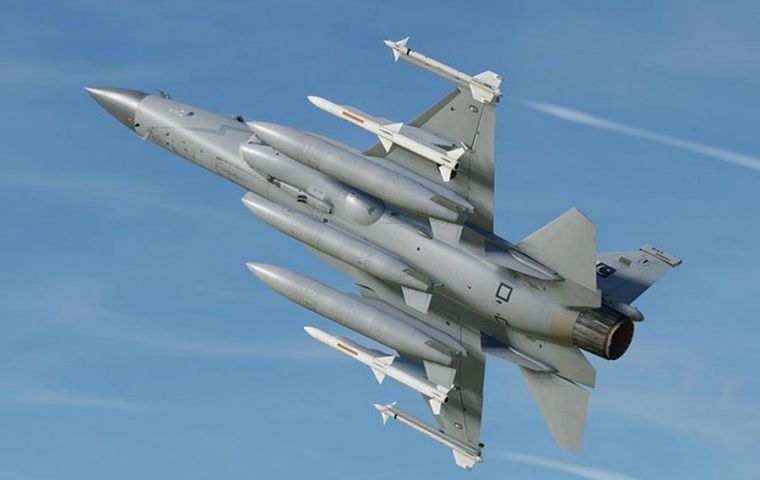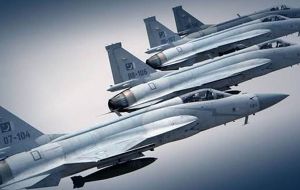camberiu
Registered
- Joined
- Mar 24, 2012
- Messages
- 3,880
- Likes
- 4,612
ARTICLE

The JF-17 fighter has been combat tested and is produced in partnership with Pakistan, which is its largest operator

There is speculation that CATIC intends to close an agreement for the supply of 12 fighters according to the Zona Militar website.
A top-ranking delegation from China's National Aero-Technology import-export corporation, CATIC, is currently in Argentina to discuss defense cooperation and with the proposal to offer the Argentine Air Force supersonic capable aircraft, according to InfoDefensa.ar, an Argentine site which specializes in defense industry issues.
Following the retirement of its latest Dassault Mirage III in 2015, the Argentine Air Force is out of supersonic fighter jets in its fleet and has been using subsonic A-4 attack aircraft while negotiating the purchase of an intercept aircraft.
The Argentine Air Force lost most of its aircraft during the Falklands/Malvinas conflict, almost forty years ago, plus the natural obsolescence during that time.
After negotiations with Korean Aerospace Industries (KAI) failed to offer the FA-50, Argentina has received offers from Russia, which includes the MIG 35, and from China.
In this case, the aircraft involved is the combat tested JF-17 fighter, produced in partnership with Pakistan, which is its largest operator. There is speculation that the Chinese export company CATIC intends to close an agreement for the supply of 12 fighters. And for that very purpose the CATIC delegation is in Argentina, according to the Zona Militar website.
Among the places to be visited by the Chinese are the facilities of FADEA, an Argentine aircraft manufacturer, which may be involved in a potential assembly of the fighters.
The option for the MiG-35 and JF-17 fighters comes after a British government veto prevents the sale of South Korean planes, which are equipped with avionics produced in the United Kingdom.
Like the MiG, the JF-17 uses an engine of Russian origin, the RD-39, a variant developed from the RD-33 used by the MiG-35. The Chinese fighter, however, is lighter and less capable of carrying weapons.
Despite this, the JF-17 Thunder has sufficient performance to carry out the interceptor fighting mission. It can reach Mach 1.6 and has a combat radius of up to 1,352 km.
The fighter has seven hard-points that can receive from infrared-guided air-to-air missiles to air-to-surface and anti-ship weaponry, as well as bombs and cannons.
Currently, the JF-17 is operated by Pakistan (138 fighters), Myanmar (16 on order) and Nigeria, which received its first three planes in 2021.
Argentina had a respectable fighter fleet, but the Air Force retired several aircraft such as the Mirage III and the Israeli manufactured IAI Kfir, unable to replenish losses in the inventory because of lack of sufficient financial resources. Currently, Argentina's air defense uses only six McDonnell Douglas A-4 Skyhawk aircraft adapted for this type of mission.
However whatever the outcome it won't be an easy operation, financing is an issue but also training personnel, since Argentine pilots and support staff are accustomed to Western (mostly US) avionics and aircraft.

The JF-17 fighter has been combat tested and is produced in partnership with Pakistan, which is its largest operator

There is speculation that CATIC intends to close an agreement for the supply of 12 fighters according to the Zona Militar website.
A top-ranking delegation from China's National Aero-Technology import-export corporation, CATIC, is currently in Argentina to discuss defense cooperation and with the proposal to offer the Argentine Air Force supersonic capable aircraft, according to InfoDefensa.ar, an Argentine site which specializes in defense industry issues.
Following the retirement of its latest Dassault Mirage III in 2015, the Argentine Air Force is out of supersonic fighter jets in its fleet and has been using subsonic A-4 attack aircraft while negotiating the purchase of an intercept aircraft.
The Argentine Air Force lost most of its aircraft during the Falklands/Malvinas conflict, almost forty years ago, plus the natural obsolescence during that time.
After negotiations with Korean Aerospace Industries (KAI) failed to offer the FA-50, Argentina has received offers from Russia, which includes the MIG 35, and from China.
In this case, the aircraft involved is the combat tested JF-17 fighter, produced in partnership with Pakistan, which is its largest operator. There is speculation that the Chinese export company CATIC intends to close an agreement for the supply of 12 fighters. And for that very purpose the CATIC delegation is in Argentina, according to the Zona Militar website.
Among the places to be visited by the Chinese are the facilities of FADEA, an Argentine aircraft manufacturer, which may be involved in a potential assembly of the fighters.
The option for the MiG-35 and JF-17 fighters comes after a British government veto prevents the sale of South Korean planes, which are equipped with avionics produced in the United Kingdom.
Like the MiG, the JF-17 uses an engine of Russian origin, the RD-39, a variant developed from the RD-33 used by the MiG-35. The Chinese fighter, however, is lighter and less capable of carrying weapons.
Despite this, the JF-17 Thunder has sufficient performance to carry out the interceptor fighting mission. It can reach Mach 1.6 and has a combat radius of up to 1,352 km.
The fighter has seven hard-points that can receive from infrared-guided air-to-air missiles to air-to-surface and anti-ship weaponry, as well as bombs and cannons.
Currently, the JF-17 is operated by Pakistan (138 fighters), Myanmar (16 on order) and Nigeria, which received its first three planes in 2021.
Argentina had a respectable fighter fleet, but the Air Force retired several aircraft such as the Mirage III and the Israeli manufactured IAI Kfir, unable to replenish losses in the inventory because of lack of sufficient financial resources. Currently, Argentina's air defense uses only six McDonnell Douglas A-4 Skyhawk aircraft adapted for this type of mission.
However whatever the outcome it won't be an easy operation, financing is an issue but also training personnel, since Argentine pilots and support staff are accustomed to Western (mostly US) avionics and aircraft.
